
|

|
Last update October 13, 2022
東大寺
|
大仏について
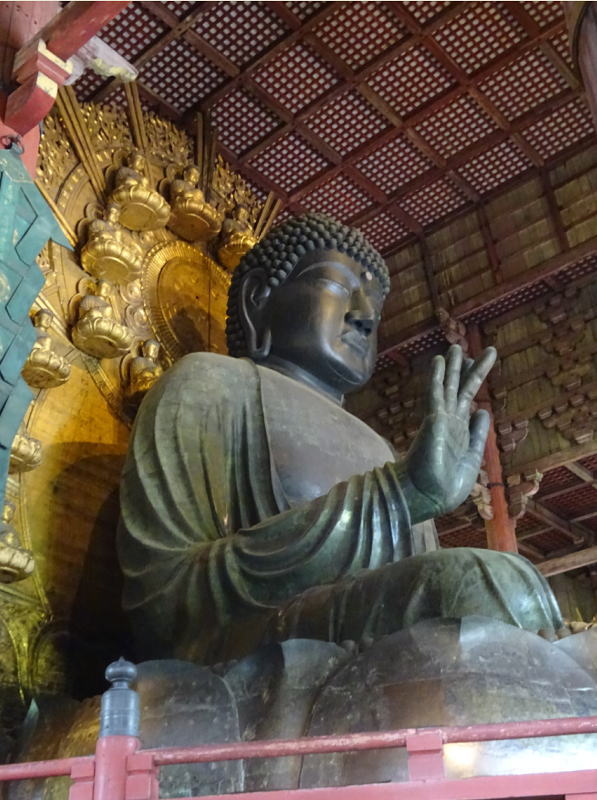
 いよいよメインの大仏さまよー。いいわよね~、ここの大仏さまってデカくって。小さい島国の日本の誇りってもんよね。そりゃ、アンタ大きいことはいいことよー。でね、仏さまもいろいろいらっしゃるのよ。阿弥陀仏(あみだぶつ)さんとか薬師如来(やくしにょらい)さんとかさ、アンタ、どの仏さまが好き?でさあ、東大寺の大仏さまはって言うと、「盧舎那仏(ろしゃなぶつ)」って言うんだって。盧舎那仏っていうのは、華厳経の仏さまらしいわ。
いよいよメインの大仏さまよー。いいわよね~、ここの大仏さまってデカくって。小さい島国の日本の誇りってもんよね。そりゃ、アンタ大きいことはいいことよー。でね、仏さまもいろいろいらっしゃるのよ。阿弥陀仏(あみだぶつ)さんとか薬師如来(やくしにょらい)さんとかさ、アンタ、どの仏さまが好き?でさあ、東大寺の大仏さまはって言うと、「盧舎那仏(ろしゃなぶつ)」って言うんだって。盧舎那仏っていうのは、華厳経の仏さまらしいわ。天平15年(743年)10月に聖武天皇は「盧舎那大仏造顕(ろしゃなだいぶつぞうけん)の詔(みことのり)」というのを出したのね。でもね、最初は、紫香楽(今の滋賀県甲賀郡信楽町)に大仏さんを作ろうとしていたらしいの。信楽(しがらき)って言えばアンタ、タヌキで有名よ。てなわけで、紫香楽に大仏さんを作り始めたんだけど、どうも良くなかったのね。何が良くないって、紫香楽の山に何回も火災が起こったり、地震が起こったりしたんで、これは縁起が悪いってことになったの。それで結局、当時の金光明寺、今の東大寺の寺域に移されることになったのね。
それから、天平17年(745年)、いよいよ大仏さんの造像工事が始まったのよ。そりゃあんだけ大きいと大変よ、作るほうも作られるほうも(?)。天平19年(747)9月から天平勝宝元年(749)10月の3年間の間に8回も鋳継ぎをして本体の鋳造が完成。天平勝宝3年(751)には螺髪(らはつ)の鋳造と頭部への取り付けが終るとともに、平行して作られていた大仏殿もだいたい完成していたんで、じゃあ、ってことで、天平勝宝4年(752年)4月に開眼供養会を行ったのね。でも、一説によるとさあ、この時点では、まだ完成していない部分もあったんだって。でも、当時は天然痘の流行とか、貴族の争いごととかがあって、なんとか良い世の中にならないかっていう切実なるものがあったのね。天皇の力が弱まって、貴族の力が強くなっていったのもこの頃よ。
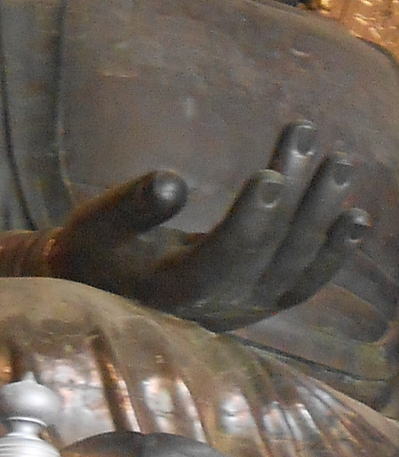
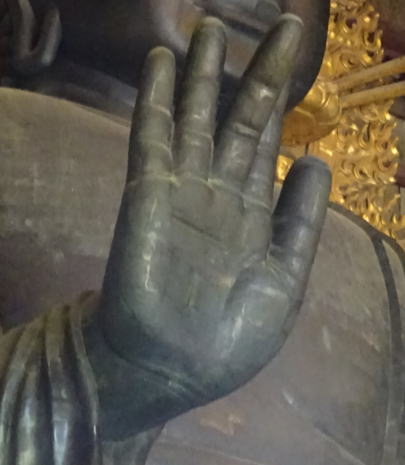 ところでさ、あんた知ってた?仏像の手のジェスチャーってテキトーにやってるんじゃないのよ。専門的には「印相」(いんぞう)とか言ってね、意味があるんだって。たとえば、この大仏の両手をチェックしてみると、上の写真の左が仏像の左手の形で、右が右手なんだけど、それぞれ「施無畏印(せむいいん)」、「与願印(よがんいん)」って呼ぶらしいわ。で、どんな意味があるかっていうと、施無畏印は「恐れなくてもいい」という意味で、与願印は「与える、願いをかなえる」って意味なのよ。なんか、ありがたい気持ちになるわね。
ところでさ、あんた知ってた?仏像の手のジェスチャーってテキトーにやってるんじゃないのよ。専門的には「印相」(いんぞう)とか言ってね、意味があるんだって。たとえば、この大仏の両手をチェックしてみると、上の写真の左が仏像の左手の形で、右が右手なんだけど、それぞれ「施無畏印(せむいいん)」、「与願印(よがんいん)」って呼ぶらしいわ。で、どんな意味があるかっていうと、施無畏印は「恐れなくてもいい」という意味で、与願印は「与える、願いをかなえる」って意味なのよ。なんか、ありがたい気持ちになるわね。Great Buddha Statue
When Emperor
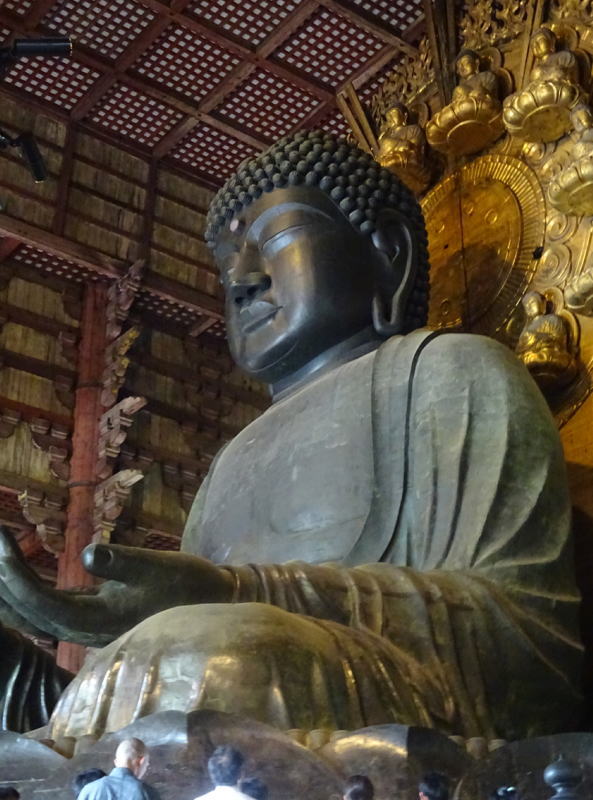 The construction of the statue started in 745. Due to the extravagant size, it required tedious procedures and a long time. Eight partial castings had to be conducted to form the body, and this process needed three years starting from September 747. The head, furnished with
The construction of the statue started in 745. Due to the extravagant size, it required tedious procedures and a long time. Eight partial castings had to be conducted to form the body, and this process needed three years starting from September 747. The head, furnished with Some records say, however, the ceremony was carried out at a somewhat premature timing, and there were several unfinished parts in the construction of the hall. The forwarded schedule seemed to have a reason. The society at that time was rife with unfortunate incidents such as epidemic outbreaks and aristocratic conflicts, and the emperor hoped the consecration of the Buddha statue might save the situation. It also coincided with the time when royal authority began to wane and the aristocrat gradually enhanced its power.
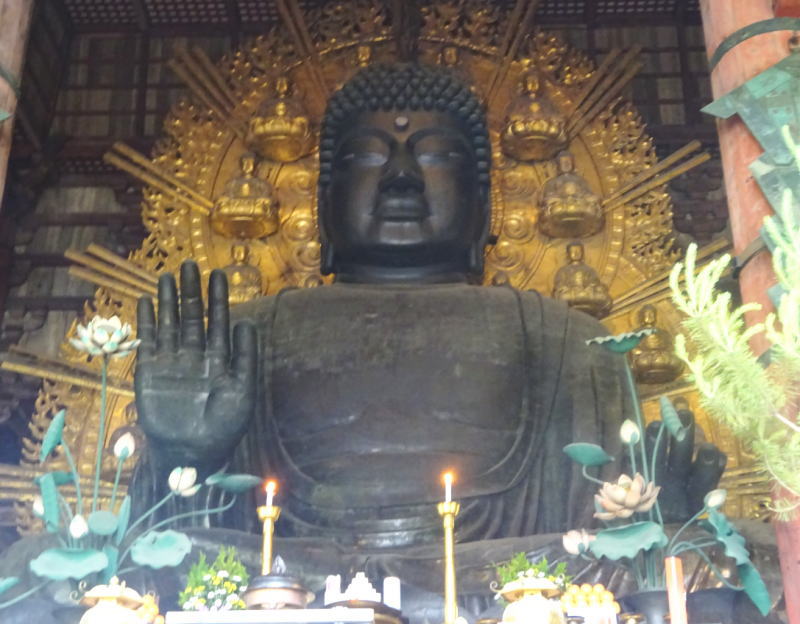 The Buddha image forms the hand signs (also called hand gestures or
The Buddha image forms the hand signs (also called hand gestures or 